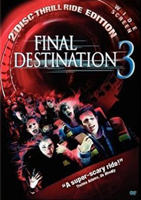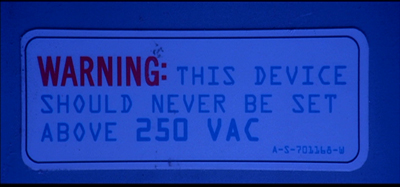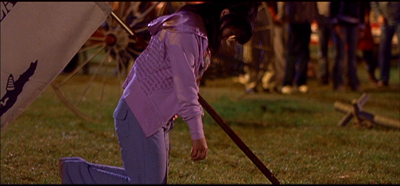 BUY IT AT AMAZON: CLICK HERE!
BUY IT AT AMAZON: CLICK HERE!
STUDIO: New Line Home Entertainment
MSRP: $29.98
RATED: R
RUNNING TIME: 93 Minutes
SPECIAL FEATURES:
• "Choose Their Fate!" interactive feature
• Commentary w/ dir. James Wong, writer Glen Morgan, DP Robert McLachlan
• "It’s All Around You" animated short
• Making-of featurette
• "Dead Teenager Movie" featurette
• DVD-ROM content
• Trailers and promotional material
The Pitch
"It’s Final Destination, but we’re going to belabor the ‘logic’ of Death’s design and get sloppy with our kills."
The Humans
Mary Elizabeth Winstead (Sky High), Ryan Merriman (Halloween: Resurrection), Kris Lemche (occasionally God in Joan of Arcadia), Alexz Johnson (Reefer Madness: The Movie Musical).
The Nutshell
The senior class of McKinley high gets a party at the local amusement park just before graduation. One icy chick with a serious aversion to fun has a freakout vision while waiting for a roller-coaster to start, in which a dropped camera causes the coaster’s cars to derail, ending in the violent deaths of everyone aboard. This girl, Wendy, manages to convince a few of her friends to get off the ride, which then crashes just as she foresaw. In series’ tradition, the survivors start to drop like flies as fate catches up to them. Thanks a lot, Wendy.

I wanna be related.
The Lowdown
Okay, you know how horror movies aren’t necessarily logical, but how they don’t work unless they’re internally cohesive? Try this on for size: the dude whose dropped camera causes the crash in Wendy’s vision is one of those to exit the roller-coaster when she freaks out. He’s not in the car, so can’t drop his camera on the track, so… why does the coaster crash, killing a dozen students and setting up the doom of the survivors? It’s not just the ride that derails there, eight minutes into the picture; it’s the whole damn film.
The problem that manifests from that first slip-up is that the filmmakers care too little about the cohesion of their movie than they do about their wacky rules of Death’s design, the guidelines which suggest how people will die, in what order, and what happens when they accidentally survive. Much more time is given to brain-dead philosophizing about the nature of Death’s design than to the actual deaths of the teenagers. It’s a poor balance for this sort of film. The audience doesn’t want metaphysical claptrap with aborted drama; we’d settle for an Occam’s Razor explanation, as long as it has momentum.

…or you’ll cause a blackout in California.
There’s a distinction that needs to be made between the illogical and the unlikely. The needless exposition is illogical in nature and content, while the tense kills thrive on unlikely events. Those get a free pass, because that is, in essence, the draw and advertised feature of the film. The first Final Destination had some outrageously unlikely set-pieces that resulted in deaths for the unlucky survivors. The sequel had the monstrously entertaining vision of the freeway pileup at the beginning. Director James Wong, who also helmed the first, tosses both in favor of his treatise on the rules of the world.
With two notable exceptions, the kill sequences are void of creativity, and are even too sudden to capture the delicious build-up of the best deaths of the film’s predecessors. Those two exceptions are the sequences involving the tanning beds and the hardware store/nail gun sequence. These throw back to the Rube Goldberg, stalked-by-coincidence fun that sizzles with humor and gore. The others flash by with hardly any preamble, much less tension or satisfaction.

If you buy the set, you’ll see her tits.
But you’ll never be able to forget those eyes… those eyes…
More than the other flicks, Final Destination 3 also emphasizes the plight of the hapless survivors in their Cassandra-esque knowledge of their impending deaths. Where the other movies had visions and hunches of deaths, right before they happened, this one gives the protagonists a set of photographs that offer clues into the violent, bloody ways our heroes will bite it. It’s a great undertone for the characters, since it not only hammers home that they are going to die, but that they are going to die horribly.
When Wong remembers that such unavoidable futures, and their realizations, are what attract the audience to the franchise in the first place, the film works. The remainder of the running time is occupied by pretensions of complexity, which breaks the inertia and, what’s worse, robs the audience of the simple joy of watching teenagers die.

So sure.
The Package
The much-touted feature on the first disc of this set is the "Choose Their Fate" version of the film. This works much like the "Choose Your Own Adventure" books that we used to love as children. At key points, a prompt will appear with a decision for the viewer to make. These are always binary choices, selectable with the remote. The choices are things like, "Should the thermostat be set to 73 or 76?" In other words, so divorced from their eventual outcomes as to make the choice purely guesswork. The good news is that you can just rewind and pick the other choice should you dislike the path you took. (I used to read those adventure books with about five fingers stuck in the pages to mark various decisions.)
It’s a neat idea, but unfortunately it adds up to nothing more than a clever way to integrate deleted scenes/alternate takes into the film. Occasionally, you make a decision which results in the film terminating early. Otherwise, the flow of events aren’t interrupted significantly. It’s not the sort of feature that other filmmakers will be wanting to spend "$500,000 to $750,000" to include, as James Wong has been quoted as saying. It’s not nearly as interactive as the marketing materials would have you believe, though I imagine it might be attempted to greater success by someone else in the future.

"My head is bloody but, uh… I flunked English."
The first disc also contains a feature commentary with director James Wong, co-writer Glen Morgan, and DP Robert McLachlan. All three are a bit too laid-back to really engage a viewer, but their nuggets of contextual history are pithy and informative. McLachlan gets the least amount of mic time, but his comments are usually the most interesting to anyone interested in the mechanics of lighting and cinematography.
The second disc is enhanced for playback in a PC, and includes website links, a dinky little game called "Visions of Death," and other bits of questionable necessity.
Aside from that, it’s got the documentaries and featurettes, including a behind-the-scenes exploration of the techniques behind the kills, easily the most complicated and thus most interesting technical aspect of the film. A second featurette is a brief history lesson in the horror subgenre of "dead teenager movies," which is a great inclusion, if for no other reason than it recognizes its irreverent tradition.
There’s also a Nick Cross/Helder Mendonca animated short called "It’s All Around You," which is a humorous slice of propaganda relating to probabilities and fear of death in a 50s educational film fashion.
There’s also one extended scene that wasn’t included in the "Choose Their Fate" feature, and a number of promotional materials, such as trailers and television spots.
6.3 out of 10